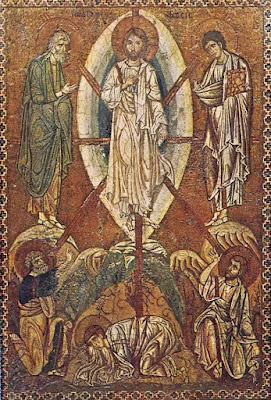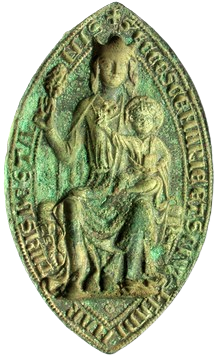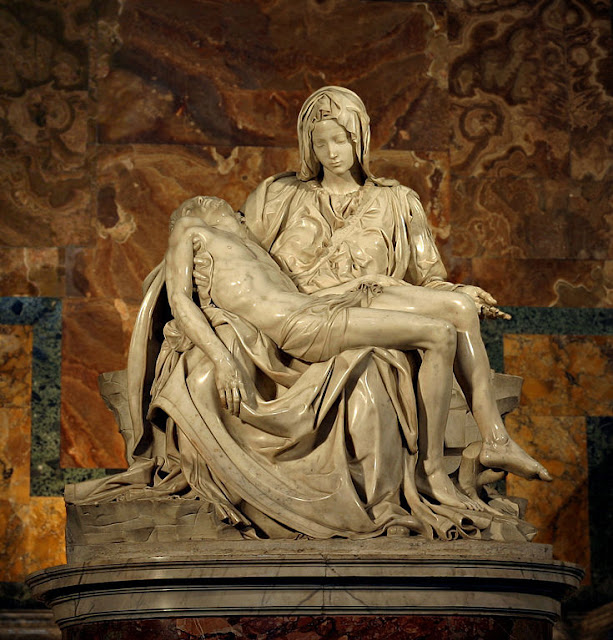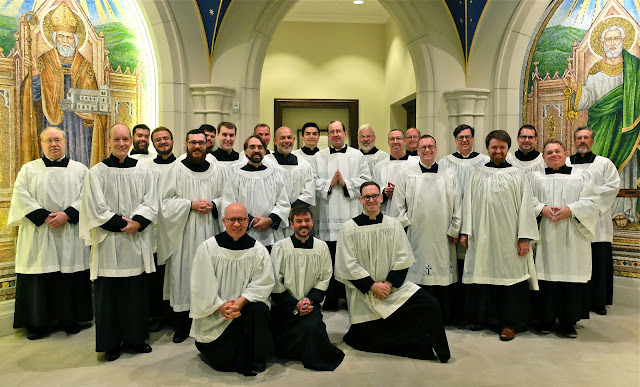The Mandorla: Shape And Meaning
Ever wonder what the curious pointed oval shape in religious art is called, the shape that is also used in various designs adopted by guilds and religious groups? That almond shape is called the mandorla, the Italian word for almond.
The mandorla is a significant symbol in Christian art and theology, characterized by its almond shape, which is formed by the intersection of two circles. This shape has deep theological implications and is often used to represent the divine presence, particularly in relation to Christ and the Virgin Mary.
Symbolic Meanings
Divine Presence. The mandorla is frequently depicted as a radiant shape surrounding Christ in His glory, particularly in scenes of the Transfiguration or the Ascension. It symbolizes the divine light and glory that emanates from Christ, emphasizing His dual nature as both God and man. The use of the mandorla in art serves to highlight the sacredness of the figure it surrounds, marking a clear distinction between the divine and the earthly realms.
Theological Significance. In theological terms, the mandorla represents the intersection of heaven and earth, the divine and the human. It is often associated with the concept of the Incarnation, where the divine nature of Christ intersects with His human nature. This intersection is a central tenet of Christian belief, affirming that Jesus Christ is both fully divine and fully human.
Symbol of Salvation. The mandorla can also be seen as a symbol of salvation and protection. In some depictions, it is used to encase figures such as the Virgin Mary or saints, signifying their sanctity and the divine protection they receive. This protective aspect is reminiscent of the biblical imagery of God’s sheltering presence, as seen in Psalm 91:1, which speaks of dwelling in the "secret place of the Most High".
Artistic Representation
The mandorla is commonly found in Byzantine and Romanesque art, where it often frames Christ or the Virgin Mary in icons and frescoes. In these representations, the mandorla is typically adorned with rays of light or other decorative elements that enhance its significance as a symbol of divine glory.
In the context of church architecture, the mandorla may also appear in the design of altars or in the layout of the church itself, reinforcing the idea of the church as a space where heaven and earth meet.
Historical Context
Historically, the mandorla has roots in earlier artistic traditions, including Roman and Hellenistic art, where similar shapes were used to denote divinity. However, its specific application in Christian art developed significantly during the early Middle Ages, particularly in the context of the Byzantine Empire, where it became a standard element in iconography.
References
- Catholic Encyclopedia Nimbus / The Encyclopedia Press
- Catechism of the Ukrainian Catholic Church: Christ – Our Pascha 612 / Synod of the Ukrainian Greek Catholic Church
- Catholic Encyclopedia The Lamb (in Early Christian Symbolism) / The Encyclopedia Press
- Catholic Encyclopedia Archæology of the Cross and Crucifix / The Encyclopedia Press
The aureole was considered exclusively a device of Christian art, especially as it was reserved at first for the Divinity, and later extended only to the Blessed Virgin. Instead of simple beams it often consists of pointed flames or is shaded off into the colours of the rainbow. This form as well as the simple nimbus (link), by the omission of the circumference, may be transposed into a garland of rays or a glory. A glory imitating the sun's rays was very popular for the monstrances, in other respects the lunula (little moon) suggests the nimbus only because the costliness of the material enhances the lustre. The aureole obtained the Italian name of mandorla from its almond shape. In Germany the fish was agreed upon for the symbol of Christ, or a fish bladder if it had the shape of a figure 8. God the Father is typified in later pictures by an equilateral triangle, or two interlaced triangles, also by a hexagon to suggest the Trinity. If there is no circle around the cross nimbus, the three visible arms of the cross give the same effect. Occasionally the mandorla is found composed of seven doves (type of the Seven Gifts of the Holy Ghost), or of angels. The latter are used in large pictures of the Last Judgment or heaven, for instance in the "glories" of Italian domes. In painting, haloes of cloud are sometimes used for delicate angel heads, as in Raphael's works. Angels also form a nimbus around the head of the Mother of God. | Catholic Encyclopedia
In the symbolism of Saint Hildegard of Bingen, the mandorla symbolizes the Cosmos (Riedel, Ingrid (1994). Hildegard von Bingen, Prophetin der kosmischen Weisheit. Kreuz Verlag, Zürich).
Symbolic MeaningsChristian Symbolism: In Christian tradition, the vesica piscis is often interpreted as a representation of Christ. The shape is reminiscent of a fish, which is an early Christian symbol (ἸΧΘΥΣ / IKhThUS, or also ἸΧΘΥϹ with a lunate sigma, is an acronym or acrostic for "Ἰησοῦς Χρῑστός Θεοῦ Υἱός Σωτήρ") that signifies Jesus Christ, Son of God, Savior (Iēsoûs Khrīstós, Theoû Huiós, Sōtḗr). The fish symbol was widely used by early Christians, particularly during times of persecution, as a secret sign of faith. The vesica piscis, therefore, embodies the idea of Christ as the source of life and sustenance, akin to the fish's association with abundance and nourishment.Sacramental SignificanceThe vesica piscis is also linked to the sacraments, particularly Baptism and the Eucharist. The water that flows from Christ's side, symbolizing the sacraments, can be seen as a representation of the life-giving waters of Baptism, which is essential for spiritual rebirth. The shape can symbolize the womb, representing the Church as the nurturing body that gives birth to believers through the sacraments.Mathematical and Philosophical ImplicationsBeyond its religious connotations, the vesica piscis has been studied in mathematics and philosophy. It represents the concept of duality—two circles intersecting to create a new form—symbolizing the union of opposites, such as heaven and earth, or the divine and the human. This duality is a recurring theme in Christian theology, reflecting the nature of Christ as both fully divine and fully human.Historical ContextThe use of the vesica piscis can be traced back to early Christian art and architecture, where it often appears in the design of churches and cathedrals. Its presence in Gothic architecture, for instance, is notable in the pointed arches and windows that resemble the shape, symbolizing the connection between the earthly and the heavenly.
- Catholic Encyclopedia Symbolism of the Fish / The Encyclopedia Press
- CCC 1220
- Haurietis Aquas 77 / Pope Pius XII
- Catholic Encyclopedia Masonry (Freemasonry) / The Encyclopedia Press
- CCC 701
| Guild (Archconfraternity) of Saint Stephen |








.jpg)





Comments
Post a Comment
Your comments will be appreciated and posted if 1) they are on topic and 2) preserve decorum.
Stand by your word.